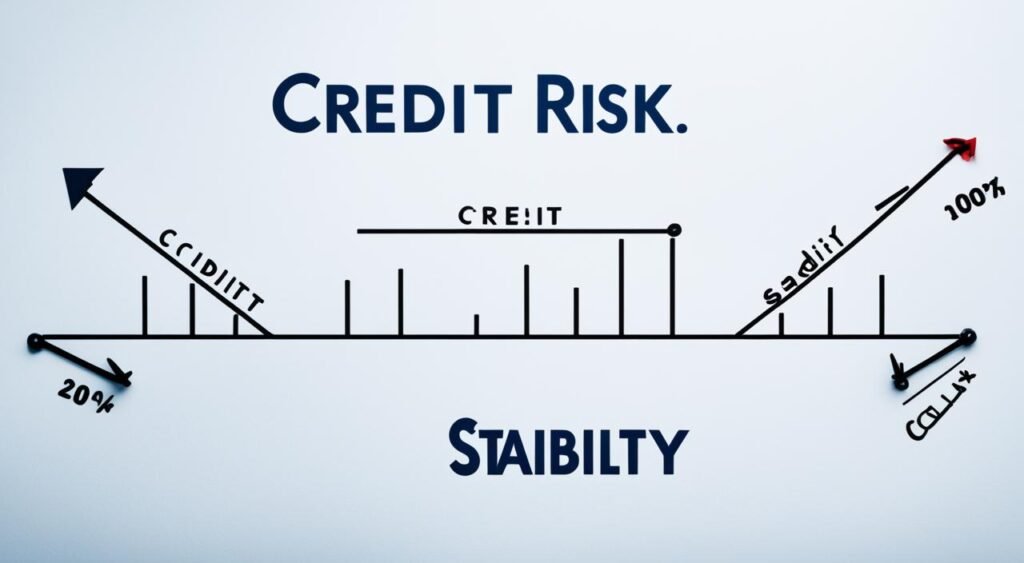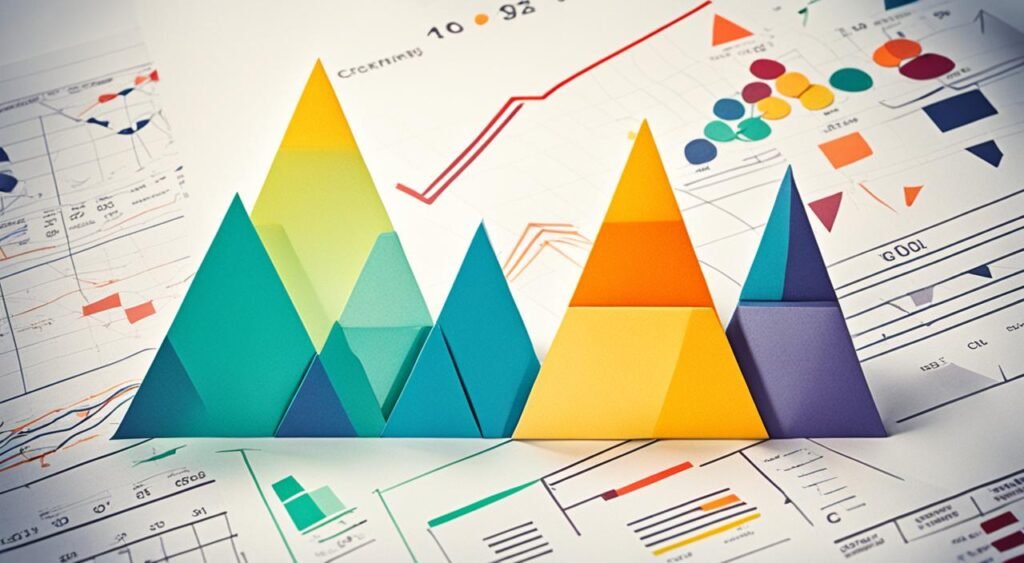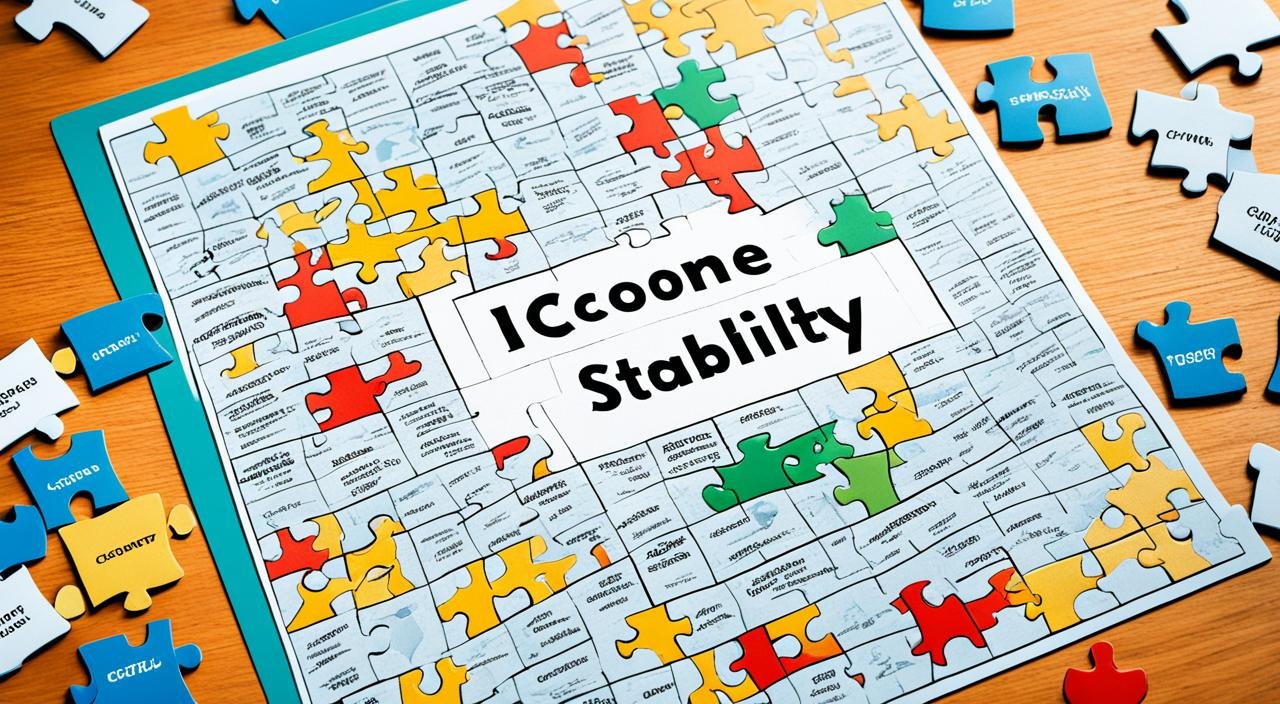In finance, understanding credit risk is very important. Credit risk is the chance of losing money because a borrower doesn’t pay back a loan. It’s about the danger of not getting the money back that was lent, slowing cash flow and increasing costs to collect debts.
To lower credit risk, lenders look deeply into a borrower’s financial health. This includes their debts, earnings, and history of repaying loans. Credit rating agencies like Moody’s and Fitch help by giving grades on how risky it is to lend money to different people, companies, or governments.
Managing credit risk well is key for banks, investors, and companies. It guides them to smart choices, protects their money, and helps them follow the law. Good credit risk management includes using models and tools to decide who to lend to, how much, and taking steps to lower risk.
Key Takeaways
- Credit risk is the chance you might lose money because a borrower doesn’t pay back a loan.
- To lower credit risk, lenders check deeply the borrower’s financial state, like how much they owe, make, and their loan payback record.
- Credit rating agencies help a lot by deciding how risky it is to give money to different types of borrowers, from individuals to companies, and even governments.
- Good credit risk management is crucial for banks, investors, and businesses to do well, protect their assets, and make more money.
- It involves using various tools to decide on loans, their terms, and also how to lessen the risks involved.
Also Read : Top 10 Benefits Of Apples For Your Health
Understanding Credit Risk
Credit risk is key in finance. It’s about the chance of losing money if a borrower doesn’t pay back a loan. Knowing about this risk helps lenders and others in finance protect their money. They can make better choices this way.
Also Read : How Can Celebrating Small Successes Keep Students Motivated?
Definition of Credit Risk
Credit risk means the lender might not get back the loan and interest. This can stop the expected income and make it harder and costlier to collect. It happens when a borrower can’t or won’t pay what they owe.
Lenders lower this risk by checking the borrower’s debt, income, and credit history carefully.
Sources of Credit Risk
Credit risk can come from many places, like the borrower’s financial health and the general economy. It includes the risk of a borrower not making payments (default risk), or a trading partner failing their obligations (counterparty risk). It also covers the danger of too many loans being in one area or industry (concentration risk).
Also Read : How Can You Make Cheese Pizza ?
Implications of Credit Risk
Credit risk’s effects can be big for lenders and borrowers alike. Lenders might lose money, face more rules, and harm their name. Borrowers might pay more for loans, find less credit available, and suffer lower credit scores. Managing credit risk well is key to financial health and keeping credit running smoothly.
| Credit Risk Factor | Description | Impact on Lender |
|---|---|---|
| Borrower’s Credit History | Past payment behavior and creditworthiness of the borrower | Helps assess the likelihood of default and inform lending decisions |
| Borrower’s Debt Load | The amount of debt the borrower currently holds | Indicates the borrower’s capacity to take on additional debt and repay loans |
| Borrower’s Income and Cash Flow | The borrower’s ability to generate sufficient income to service debt | Determines the borrower’s capacity to repay the loan |
| Collateral and Guarantees | Assets or third-party commitments that can be used to secure the loan | Provides a source of repayment in the event of default and reduces the lender’s risk exposure |
| Macroeconomic Conditions | The overall state of the economy, including factors such as interest rates, inflation, and unemployment | Can impact the borrower’s ability to repay the loan and the lender’s risk exposure |
Measuring Credit Risk
Measuring credit risk is key in financial management, helping lenders and investors make smart choices. It involves using credit scoring models and reviews by credit risk rating agencies.
Also Read : How Can You Make Cheese Sandwich?
Credit Scoring Models
Lenders use credit scoring models to check how likely borrowers are to repay. These models consider things like credit history, debt, income, and job. They give a credit score showing the repayment odds. Then, lenders decide on credit risk and loan prices.
Credit Risk Rating Agencies
credit risk rating agencies are also important in checking credit risk. Moody’s, S&P, and Fitch are examples. They evaluate entities’ credit health, from businesses to governments and bonds. Then, they provide credit ratings. Higher ratings mean lower risk, and vice versa.
The work of credit scoring models and rating agencies is crucial for understanding and managing credit risk. This applies to different financial areas, like personal loans, business lending, and investing.
Also Read : What Are The Best Ways To Train Domesticated Cat?
Mitigating Credit Risk

Financial institutions use various credit risk management strategies to reduce losses. They set credit risk policies and standards for lending. For example, they may need a certain credit score from borrowers. This makes sure that borrowers are likely to pay back their loans, lowering the risk of default.
Credit Risk Management Strategies
Banks and other lenders often keep an eye on their loan portfolios. They check if the creditworthiness of borrowers is changing. This allows them to spot and deal with any new credit risks fast. They also use credit risk controls like credit risk limits and solid credit risk reporting to improve how they manage credit risk.
Risk-based Pricing
Risk-based pricing is a key method to avoid credit risk. Lenders might give higher interest rates or fees to those with greater credit risk profiles. This is after looking at the credit risk assessment and credit risk analysis. The higher charges help cover the additional credit risk exposure and make sure the lender is well-paid for the risk they take.
Additionally, lenders might use credit risk hedging methods. This can involve credit risk transfer with instruments like credit default swaps. They might also spread their loan portfolio across different areas and industries for credit risk diversification.
| Credit Risk Mitigation Strategies | Description |
|---|---|
| Credit Risk Policies and Standards | Establishing specific lending criteria, including minimum credit score requirements, to ensure borrower creditworthiness. |
| Credit Risk Monitoring | Regularly reviewing loan portfolios to identify and address any changes in borrower creditworthiness. |
| Credit Risk Controls | Implementing robust credit risk governance, including credit risk limits and reporting mechanisms. |
| Risk-based Pricing | Charging higher interest rates or fees to borrowers with higher credit risk profiles to offset the increased exposure. |
| Credit Risk Hedging and Diversification | Utilizing credit risk transfer instruments and spreading the loan portfolio across different industries and regions. |
credit risk in Lending
Lenders need strong strategies when dealing with credit risk. They look at five things: character, capacity, capital, collateral, and conditions. These help them understand, measure, and reduce credit risk.
Consumer Credit Risk Assessment
In consumer lending, lenders check a person’s credit history and debt. They also see if there’s anything of value they can use as collateral. This is how they figure out how risky it is to lend to someone. They then set limits and use spread-out techniques to manage that risk.
Commercial Credit Risk Assessment
For businesses, credit risk is more complicated. They often want more money and have complex financial setups. Lenders look at industry type, the management team, and the business’s risk rules. They use both financial data and other details for a full picture of the risk.
Good lending practices are crucial for all types of loans. They help lenders keep their loans healthy, follow the law, and stay financially strong over time.
Credit Risk in Investments
When looking at investment chances, understanding credit risk is key. This is especially true in the bond market. Agencies like Moody’s Investors Services and Fitch Ratings help with this. They look at the stability of the issuer, their debt, and how well they’ve paid back before. Then, they give it a rating.
Bond Credit Ratings
Thinking of buying a bond? You should look at its credit rating first. If it’s rated below BBB, it’s seen as high risk. This means the issuer might not pay interest or the full amount back when the bond matures. On the other hand, ratings of BBB or higher are less risky. They are better for cautious investors.
Credit Default Swaps
A credit default swap (CDS) is a handy tool for managing risk. It’s a contract that lets investors put the risk of a bond or debt on someone else. This way, if the issuer can’t pay, the investor might not lose.
Understanding credit risk is challenging but important. This knowledge helps investors in making smart choices. It lets them handle the natural risks in their investments better.
Regulatory Aspects of Credit Risk

The world’s financial landscape is guided by important rules. These rules make up the basis for managing credit risks at banks. They’re set by global standards to keep the finance system safe. The Basel Accords and stress testing requirements are two key examples. They help ensure that banks can deal with risks well.
Basel Accords
The Basel Accords are rules by the Basel Committee on Banking Supervision. They set goals for how much money and assets banks should have. The idea is to make sure banks are strong enough to face risks. Following these rules not only makes banks safer but also better at handling their money and risks.
Stress Testing Requirements
Aside from the Basel rules, there are also stress testing rules. These tasks check if banks can handle tough times. Banks must do things like credit risk monitoring and credit risk reporting. This helps them know their risk limits and how to control them. It’s all about being ready for unexpected financial hits.
By sticking to these rules, banks show they’re stable and trustworthy. This attracts both investors and customers. So, these rules benefit the whole finance world.
Credit Risk and Financial Stability

The way financial institutions handle credit risk is super important. It affects how they save money, follow laws, and make a profit. Good management helps lower the chances of people not paying back loans. This lets banks lend smarter and earn more money in the end.
Systemic Risk Considerations
Managing credit risk also keeps the whole financial system safer. If this risk gets out of hand, it can cause big problems for the economy. That’s why regulators watch closely and make sure banks handle their risks well.
Counter-party Credit Risk
Financial firms need to watch not just their own loan risks, but also the risks of others they do business with. For example, in deals like derivatives or lending to other banks. If these risks aren’t managed, it could mean big losses. And this could mess up how the market works. Using smart models and spreading out risk are key ways to deal with this.
Keeping a strong system to manage credit risk helps banks protect their money and earn better. It also helps make the financial system overall more stable. This means using advanced models, solid policies, and promoting a culture that’s all about managing risk well.
Also Read : Secure Your Future With Security Finance Bank – Trust In Us
Credit Risk Modeling Techniques

Credit risk is a big deal for banks and other financial companies. They use special ways to understand and watch over this risk. One big help is credit risk modeling. It lets them check if someone or a business can pay money back. This is key for making smart loans, following the rules, and keeping loans in good shape.
For people getting loans, lenders look at lots of things. They study what you own, owe, how much you make, and how you’ve handled credit before. This look into your info helps them guess if you might not pay and decide how much to charge you for a loan.
With businesses, it’s a bit more tricky because they often borrow more. Lenders look at both numbers and details about the company. They use stuff like financial health checks, comparing to similar companies, and guessing future money moves. All to figure out the chances of not getting paid back.
No matter who’s borrowing, banks work hard to have solid rules and ways to handle credit risk. Having a good system helps them stay in a good place with risk, choose the right amount to lend, and lower the risk in smart ways, like spreading it out or moving it to someone else.
Emerging Trends in Credit Risk Management

The world of finance is changing fast. This includes how we manage credit risks. Two big trends, fintech and sustainable finance, are reshaping the future of credit risk management.
Fintech and Credit Risk
Fintech is changing the way we look at credit risks. Companies in the fintech sector use new tech like big data, machine learning, and AI. They do this to better understand and predict credit risks. This means lenders can make smarter choices and manage risks better.
Sustainable Finance and Credit Risk
Nowadays, sustainability plays a big part in managing credit risks. Banks and other financial institutions look at ESG factors when checking on credit risks. This helps them see if a business model is sustainable in the long run. They use this info to lower the risks linked to the environment, society, and good governance. This approach also meets the rising demand for finance that is both responsible and sustainable.
Conclusion
Effective credit risk management is key in finance. It protects capital, meets rules, and boosts profit for lenders. By checking credit risk well, lenders pick wisely, reducing bad loans and keeping strong financially.
Banks use smart credit risk mitigation like lending rules and keeping an eye on loans. They adjust risks and use new credit risk modeling. This includes tools from fintech and eco-friendly finance. It all helps banks measure and handle risks better.
The world of finance is always changing. Dealing with credit risk challenges needs constant watchfulness. Technology and market moves also impact credit risk management. Financial bodies must keep up. They should use the latest tools for credit risk assessment and credit risk analysis. This helps them stay secure in lending, helping the market grow stronger.





